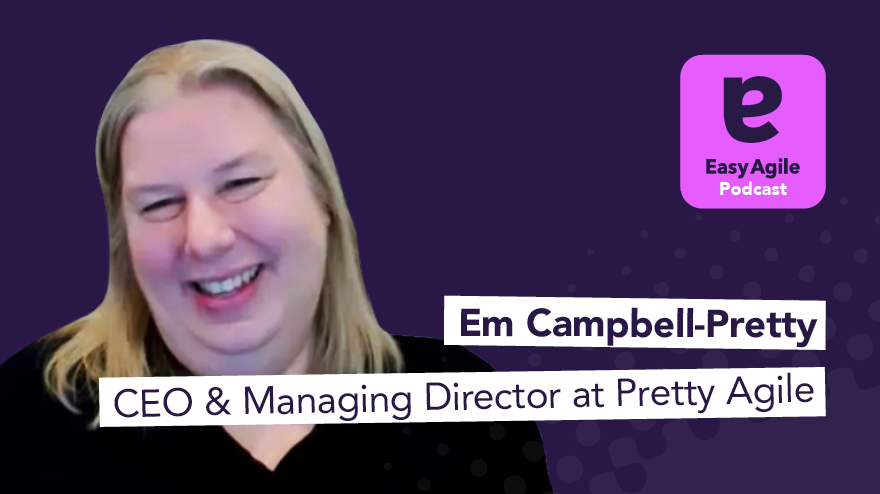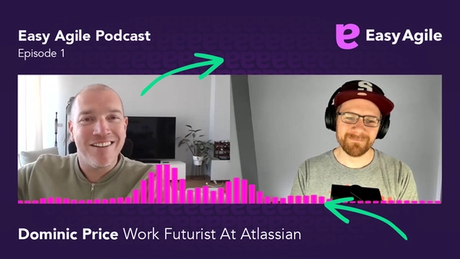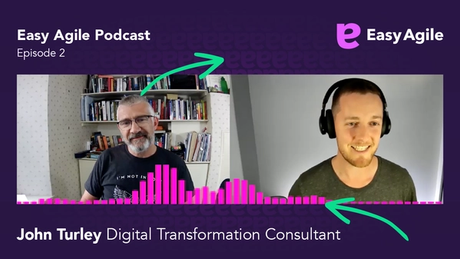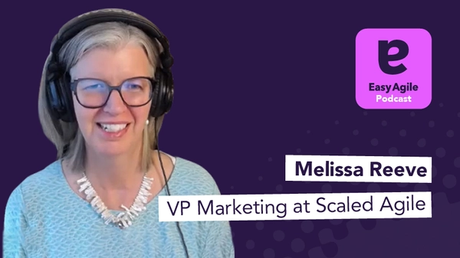Podcast
40 min read
Easy Agile Podcast Ep.4 - Em Campbell-Pretty, CEO & Managing Director at Pretty Agile
Mon Nov 30 2020

"We spoke in detail about scaling agile, being a SAFe fellow, discipline, the traits of effective leaders and how to trust your people."
Listen now on:
Transcript
Nick Muldoon:
Good day, folks. Thanks for joining us for another Easy Agile Podcast. This morning, I'm joined by Em Campbell-Pretty of Pretty Agile. Em is one of 22 SAFe fellows globally and she's been doing agile transformations at scale for over a decade now. She's also the author of two books, The Art of Avoiding a Train Wreck and Tribal Unity. So, all about culture and psychological safety here, and all about obviously scaling agile release trains, tips and tricks.
Nick Muldoon:
My key takeaways that I was really jazzed about, the traits of effective leaders for scaling agile transformations and being an effective organization, trust, as in trusting their people, an openness to learning and a willingness to learn, the ability to experiment and treat things as failures if they are failures, and discipline. Em and I talked a bit about discipline today as a trait of leaders. It's a really great episode and I took a lot from it, and you'll hear my takeaways at the end and what I need to go and learn after some time with Em this morning. So, let's get started. How many weeks a year are you typically on the road?
Em Campbell-Pretty:
How many weeks a year am I typically on the road? A lot, most. It would be unusual for me to spend four weeks without going somewhere. That would be unusual. I don't travel every week, but I travel most weeks, and I travel in big blocks. Right? So, I'll go and do ... Like I said, just before the lockdown, we did three weeks in Auckland, so that was in February-March.
Em Campbell-Pretty:
We went to Auckland, we had a client in Auckland, we just stayed there. So, three weeks in Auckland, came back here, and did not return to Auckland. Returned to support that client virtually over Teams and Zoom was how that one went. But yeah. Normally between running around Australia, Southeast Asia, Hong Kong, Singapore, Manila, the US, New Zealand, yeah, not home that often, normally. This has been truly bizarre.
Nick Muldoon:
So, this is a very unusual year for someone like yourself that's flying around visiting clients all over the world.
Em Campbell-Pretty:
Absolutely. Absolutely. It's been a very strange year. It's an interesting difference on energy as well. Not flying all the time I think is good for my body. I feel the difference. I also feel the difference sitting in a chair all the time. So, I was traveling a lot, but I was on my feet most days when I was working. Now if I'm working, I'm sitting a lot.
Nick Muldoon:
You're sitting down. Yeah.
Em Campbell-Pretty:
So, that's interesting. But I don't miss the jet lag at all. I don't miss the amount of time the travel consumes at all. In fact, it's been nice. I've had a little bit of head space. I've probably blogged more this year than I have in a few years because I've just had some head space and being able to think. But I don't get to see the world either, and all my holidays got canceled. So, nevermind work. I had trips to Europe. Four weeks from now, I was supposed to be in Canada seeing polar bears.
Nick Muldoon:
Aw.
Em Campbell-Pretty:
Tell me about it!
Nick Muldoon:
I would love to see polar bears. They look so cuddly on TV. I'm not sure that that would actually be the circumstance if I was to try to approach one and give one a cuddle.
Em Campbell-Pretty:
Yeah. I don't think cuddling was involved. I was told I could bring a camera and a tripod, which means obviously I'm going to stand some distance away from this polar bear and take photos. But that will not be happening either. So, no holidays and no travel for work, and of course, being in Melbourne, not even any, let's just go to [crosstalk 00:04:15].
Nick Muldoon:
Coffee or anything like that.
Em Campbell-Pretty:
Just nothing.
Nick Muldoon:
Nothing.
Em Campbell-Pretty:
Nothing.
Nick Muldoon:
Yeah, because you've been on legit lockdown.
Em Campbell-Pretty:
Yep.
Nick Muldoon:
So, tell me then about the shift over the last 10 or 15 years in these scaled, agile transformations. Obviously today, like you described with this client in Auckland, everything's got to be remote. Presumably, not as effective. But I'd love to get a sense of what the evolution is from the transformations 10 years ago, banking, telcos, that sort of environment to the clients that you're working with today. Describe what it was like 10 years ago.
Em Campbell-Pretty:
So, 10 years ago, and it's so interesting to reflect on this now, I read Scaling Software Agility, which is a book that Dean published in 2007. Then I discovered that wasn't the latest book, so then I read Agile Software Requirements. This was 2011. I'm this crazy, angry business sponsor with this program of work I'd been sponsoring for five years that's never delivered anything, and in this cra-
Nick Muldoon:
You were the crazy, angry business sponsor?
Em Campbell-Pretty:
Yeah. Yeah, yeah. I was the crazy [inaudible 00:05:26]. I was very angry. You would be angry too if you were me. I refer to it now as the money fire. So, basically, here's my job. Right? Go to the CFO, ask for money. Give the money to IT. IT lights a match, sets it on fire. Comes back, asks me for money. I get to go back to the CFO and say I need more money. Five years. Five years. That's all I did. Ask for money and try to explain where the other money went.
Em Campbell-Pretty:
Anyway, in the strangest restructure ever, I end up the technology GM for the same group I had been the business sponsor of for the past five years. Apparently, they couldn't find anybody appropriately qualified. So, you can do it, Em. Sure. So, I'm a bit of a geek, so I read books, and I'm reading these books by Leffingwell because I'd been doing some agile ... So, I'd been doing something I'd been calling agile. Let's just go with that.
Em Campbell-Pretty:
It was interesting to me because I could see little rays of light. But it still wasn't really making anything happen, so hence the reading. These books talk about this agile release train [inaudible 00:06:46] that sounds cool. We should so do this thing. So, I set about launching this train at a Telstra in early 2012. It wasn't called SAFe, right? It was just the books and these things called an agile release train.
Em Campbell-Pretty:
Now, to look back 10 years ago, it wasn't called SAFe. People weren't running around doing this. I was not actually really qualified for the job I was in. Well, I wasn't a technology leader by any stretch of the imagination, and I decide that I'm just going to launch an agile release train. So, there were rare and unusual beasts, and I'm not sure I really understood that when I went down the path of doing it.
Em Campbell-Pretty:
I'm big on the, I read it in a book, I read it in a blog, I heard it at a conference, I'll just try it. That's very much always been my mental model. So, I read it in a book and I just tried it. Then we discover that actually, literally nobody is doing this, so it becomes Australia's first agile release train and Australia's first SAFe implementation. Oh, boy, have I learned a lot since then.
Nick Muldoon:
Well, yeah. I was reflecting on that because I dug out The Art of Avoiding a Train Wreck, right? This is one of the ones that you signed for Tegan. But obviously, you've learned a ton since then because you've managed to put together a tome of tips and tricks and things to avoid as you are pursuing these transformations. As an industry, though, well, as an industry, I guess this spans many industries, but as a practice these days, are we actually getting better at these transformations? Are there companies out there today, Em, that are still taking piles of money and setting it on fire?
Em Campbell-Pretty:
So, I think I meet people every day who hear my story and go, "Oh, my god. You used to work here?" So, I think there's still many, many organizations that have an experience that is like the experience I had back in 2010 and what have you. So, it seems to be something that really resonates with people. I guess so many of the businesses we go into now either are not agile at all or, I guess like my world was, doing something they call agile. What we find is the something that they call agile, I wouldn't say it's not agile. But it leaves a lot to be desired.
Nick Muldoon:
They're on a journey, right?
Em Campbell-Pretty:
Yeah. Yeah. Well, I guess so because they end up having a conversation with us. So, they understand that what they're doing is not enough. They understand that what they're doing isn't getting them the results that they want. I don't know that they understand why. It's interesting to me sometimes that they look to SAFe because you asked me about how's the client base changed? One of the things that's really interesting in Australia is we get far more of the small to medium sized companies now than the big ones.
Em Campbell-Pretty:
So, they're companies that consider themselves agile. But what we're calling them, the startups that are no longer startups, right? These are organizations that they're generally old 10, 20 year old startups and they're scaling and they see their problem as a scaling problem. So, that's what leads them to a conversation around the scaled agile framework.
Em Campbell-Pretty:
When we look at them through a SAFe lens, we go, "Gee, you're tiny. But okay. I can see that you can have an agile release train and it won't do you any harm. In fact, it would probably help you a lot in terms of mid-range planning," because mid-range planning just seems to be nonexistent for a lot of these organizations. Prioritization. A lot of these small organizations, very knee-jerky in terms of how they prioritize, bouncing from one thing to the other.
Nick Muldoon:
Are they reacting to the market, or are they reacting to the leaders, maybe the lack of discipline in the leadership?
Em Campbell-Pretty:
You know what? They would say they're reacting to the market. I would say they've got a discipline issue.
Nick Muldoon:
Yeah. [crosstalk 00:11:23].
Em Campbell-Pretty:
So, I read, obviously, big reader, last summer, obviously Australian summer, US winter, I read Melissa Perry's The Build Trap. Interesting book and your well respected thought leader in product management. Not a big fan of SAFe. Probably not a big fan of agile either was the takeaway I had from her book. But the thing that she does talk about that I really thought was valuable was the lunacy in chasing your competitors. So, building features because your competitors-
Nick Muldoon:
Your competitors [crosstalk 00:12:06].
Em Campbell-Pretty:
... build them, or building features to land a contract or retain a customer. So, I thought she sees all of that as lunacy, and I tend to agree. So, that was my ... I think that's quite interesting. Her perspective is you don't know if the competitor's actually having any luck with that thing that they've built. So, if you build it because they built it, you don't know. You have no idea. So, don't just build it because they've built it. It might not be doing them any favors either.
Em Campbell-Pretty:
Of course, once you start just doing random stuff for this big customer or this big client, you start to lose your way as an organization. People end up with completely different versions of their products, branches that they can't integrate anymore. It's interesting. So, when I look at that, I go, "I feel like there's a discipline issue in some of these organizations at the leadership level."
Em Campbell-Pretty:
What is it we're trying to do? What is our vision? What is our mission? What is our market? What are we doing to test and learn in that market, as opposed to just get a gun, let's do everything, grab everything? Oh, my goodness. They were doing that over there. Stop this, start this, stop this. Of course, if you're stopping and starting all the time, you're not delivering anything, and that seems to be something that we see a lot with these organizations. They're not delivering.
Em Campbell-Pretty:
I'm not saying their delivery mechanism is perfect. There's challenges there too. But some part of the problem is the inability to stay a course. Pick a course and stay a course. I'm not saying don't pivot, because that's stupid too. But being more deliberate in your choices to pivot, perhaps. Yeah.
Nick Muldoon:
Do you get a sense, Em, that there are leadership teams in various geographic regions that are more effective at this and more effective at that longterm planning and having that discipline and that methodical approach to delivery over an extended time period?
Em Campbell-Pretty:
I think regions and cultures and nationalities certainly play a role in the leadership, I don't know, persona, personality. I don't know that I could say when I've worked in this country or this part of the world that their leaders are better at forethought. I think some cultures lend themselves to lean and agile more than others. Hierarchical cultures are really, really challenging.
Em Campbell-Pretty:
That can be both a geographic thing, but it can also just be an industry thing, right? So, government can be very hierarchical. The banks can be very hierarchical. Some of the Asian cultures are very hierarchical. But some companies are just very hierarchical as well. So, who owns the company, who leads the company, all of that can play a big role in what's acceptable because so much of success in this scaled agile journey comes down to a leadership that is willing to trust the teams, a leadership that is willing to learn, a leadership that's willing to experiment, and a leadership that's prepared to be disciplined.
Nick Muldoon:
So, leadership with trusting the teams, willing to learn, willing to experiment, and with discipline. They're those four things that you-
Em Campbell-Pretty:
Yep.
Nick Muldoon:
Yeah, okay. I'll make a note of those, Em. I'll come back to those. Trust, learn, experiment, and discipline. I'm interested, I guess, this year being a very interesting, a very unique year for doing remote transformation work and coaching and consulting, 10 years ago, what was the percentage of remote team members distributed teams? Now, you've basically, I think the big banks in Australia aren't even going back to the office until 2021. Atlassian is not going back to the office until 2021. Twitter, Jack Dorsey, my old CEO, said, "Work from home forever," sort of thing. What's the takeaway for this year and what do you expect for 2021 and beyond?
Em Campbell-Pretty:
So, look. This year has been eyeopening, and look, some things are, as I would have anticipated, some things have been different. So, obviously, we're seeing entire organizations going online. We're seeing the teams are online, the PI planning's online, everything's online. That's actually in some ways opened up opportunity. So, where we've had clients who have had the most odd setups in terms of distribution, and you can make a train work where you've got teams across two locations. But we're big fans of the entire team is in Sydney or the entire team is in India. We don't have half the team in Sydney and half the team in India.
Em Campbell-Pretty:
But organizations really struggle with that because perhaps all the testers are in India and then you want a tester on every team and now you've got a problem. How do you create a complete team and not cross the time zones? So, the opportunity becomes if I can find teams that are not physically co-located but time zone friendly, I have a little bit more option. So, I can have a train that operates between, I don't know, Sydney and India. Or I can find a four hour overlap in their day, and I can insist that that team works 100% online.
Em Campbell-Pretty:
So, the big thing that we'd advise against is I don't want that team hybrid. Right? I don't want three people sitting in the office in Sydney and three people sitting in their homes in India. I want everybody online. I want an even playing field, and I think we can do that now in a way that is more acceptable than before. Because the same advice I was giving, gee, back when I wrote Tribal Unity, same advice. Right?
Em Campbell-Pretty:
So, 2016, everybody, equal playing field. If you're going to be distributed, everyone has to be online, as opposed to some people online and some people in a room. So, that's a more acceptable answer now than it was prior to this year. So, that's good. I think that's good.
Nick Muldoon:
In 2021, then, Em, you mean this is just going to play forward. I guess there's going to be a reversion of some of these companies back to the office because they've got huge real estate and workplace infrastructure already.
Em Campbell-Pretty:
Yeah. So, look. We're seeing clients closing offices the same way that you see some of the companies in the US doing that. We're also seeing parts of Australia and New Zealand with no particular COVID impact at this point actually going back into the office, and having created that example of teams that are crossing time zones, and then going back into the office and going back to that hybrid space. So, that's interesting and [crosstalk 00:20:08].
Nick Muldoon:
So, where you're back into that environment where you might have some people working together in an office that can get a cup of coffee together and then some that are stuck still at home. I guess there's not just even regional differences, right? If you've got a team member that's got a particular health situation, they're not going to feel comfortable necessarily coming back into the office, regardless of the situation, until there's a vaccine or something.
Em Campbell-Pretty:
Absolutely.
Nick Muldoon:
Yeah, okay.
Em Campbell-Pretty:
So, yeah. Look, I think it's going to be interesting. I would strongly advocate that organizations have teams that are either in person teams or online teams, and the team just either operates 100% online or the team operates 100%-
Nick Muldoon:
In the office.
Em Campbell-Pretty:
... in person and in the office, and if you have a train that has both in any train level ceremony, everybody goes to a desk and-
Nick Muldoon:
And do it online.
Em Campbell-Pretty:
... a video camera and we do it that way. I think the thing that seems to be most sticky about the physical environment and SAFe is PI planning. Nobody needs to beat. Right? That was cool. Nobody needs to beat, no one's PI planning slipped, everybody just went. They were all online. So, we'll just PI plan online. It'll be fine. We saw people use whatever infrastructure they had available to them.
Nick Muldoon:
Yeah. [crosstalk 00:21:30].
Em Campbell-Pretty:
So, I'm sure a number of people called you folks and said, "We need a tool." But some just went, "We have Google Suite, we have Microsoft whatever it is, we have this, we have that. We're just going to make it work," and no matter what they used, they made it work and they ran the events and their events were effective and they got the outcomes. The big thing that is missing is that energy. You can't get the energy of 100, 200 people in a room from an online event. But mechanically-
Nick Muldoon:
We can achieve it.
Em Campbell-Pretty:
... we can achieve it. So, we hear everybody wants to go back to PI planning in person because of the social, because of the energy, which I think is awesome. I absolutely think that is awesome, and I can see this world in which people do a lot more work from home, work remote, whatever that looks like, and then the PI planning events are the things that we do to bring ourselves together and reconnect on that eight, 10, 12 week basis. That's my feeling. Could be wrong.
Nick Muldoon:
I guess I'll be really interested to see how it plays out, and I think we should return to this conversation in 12 months, Em.
Em Campbell-Pretty:
Yeah. Oh, no.
Nick Muldoon:
I'm just thinking, what's going through my mind is one of our customers in New York, financial services company, and for one of their arts, it was 150,000 US exercised to bring their people together once a quarter.
Em Campbell-Pretty:
Yeah. Wow.
Nick Muldoon:
I'm now going, I'm like, "Okay, yes, they're doing it digitally now." That's fine. They're going to miss out on things. But if they lose the budget, do they have to fight to get the budget back? Or does the budget sit there? There's these other unknown ramifications of this shift over the course of 2020 that we're yet to see play out, I guess.
Em Campbell-Pretty:
I think you're right, and I think it would be particularly interesting for the trains that have been launched remotely. So, if the train has been launched remotely, do you ev-
Nick Muldoon:
So, not existing trains that have been working together for six to 12, 18 months. But you want to get a brand new train started. Have you done that remotely this year with some of your clients?
Em Campbell-Pretty:
Oh, we're in the process of doing it now.
Nick Muldoon:
Cool. Tell me.
Em Campbell-Pretty:
We had one, though, literally just before the lockdown. So, they did their first PI planning face to face and then immediately moved to remote working and, yeah, now working on remotely launching a train. For us, we have a playbook. It's a bunch of workshops. It's a bunch of classes. We just use online collaboration tools. We've found things that replicate the sort of tools that we would have in a physical room, and the joy of being able to read people's Post-it notes, right? This has been the absolute highlight for me, the joy of being able to read people's Post-it notes.
Nick Muldoon:
No more hieroglyphics.
Em Campbell-Pretty:
Yeah. Absolutely.
Nick Muldoon:
What is that that you wrote, Sally? Yeah.
Em Campbell-Pretty:
Everyone can say everything at once, right? So, you think about the classroom and the workshop where there's a group of people huddled around Post-its and a flip chart paper and they're still huddled in a way in their virtual huddle, but everybody can read, right? It's not that I'm not close enough, I can't read, I can't read your handwriting. There's this great equalizer is the online world. So, I think that's great. I think the challenge for the trains launched remotely is going to be do you ever get the face to face experience?
Em Campbell-Pretty:
Because if I go back over the years, one of the things we know is your first PI planning event sets the standard. So, people get this imprint in their heads of what is possible. For example, if you skip something in your first PI planning event, you just decide to, I don't know, skip the confidence vote or something weird like that, you don't do the roam of the risks or you just skip something, you never do it because you're successful without it.
Nick Muldoon:
It never gets picked up. Yeah, okay.
Em Campbell-Pretty:
You're successful without it. So, every compromise you make, and you make a series of compromises, and then you're successful despite those compromises, and that becomes a false positive feasibility. It tells you, yes, I was right. I was right.
Nick Muldoon:
I don't need to do that.
Em Campbell-Pretty:
I didn't need to do those things because I was awesomely successful and I didn't do these things. So, it's the learning [crosstalk 00:26:15]-
Nick Muldoon:
That's confirmation bias, is it?
Em Campbell-Pretty:
Yeah, that's it. That's the one. Confirmation bias. That's exactly it. Yep. Yeah, and I think there's going to be a bunch of confirmation bias in these remotely launched trains, and unless they're inside organizations where there's enough knowledge of SAFe and the physical PI planning to know that there's going to be value in bringing them together, but I can see that being a real challenge. I think trains that are launched online may never go into a physical PI planning event because of that confirmation bias.
Nick Muldoon:
All right.
Em Campbell-Pretty:
That makes me really sad.
Nick Muldoon:
I want to come back to something you said before about the leaders, and you mentioned the trust, the openness to learning and experimentation, and the discipline. I was going back over your SAFe Global 2018 talk about the seven traits of highly effective servant leaders.
Em Campbell-Pretty:
Yep.
Nick Muldoon:
Yeah?
Em Campbell-Pretty:
Yep.
Nick Muldoon:
I guess I had some questions about this, and obviously, these are four of the traits. What are the other three traits that I'm missing? Then I've got a followup question about some of the actual things that you talked about that you picked up in your trip.
Em Campbell-Pretty:
[inaudible 00:27:29] one of those four on the list I had in 2018.
Nick Muldoon:
I'll quiz you on it.
Em Campbell-Pretty:
How awkward. So, in 2018, the answer was people first, a respect for people, that sort of lens, lean thinking, manager, teacher, learner. So, we had that one. Yeah. Learner. [inaudible 00:28:00] crazy. What else did I have? [inaudible 00:28:10].
Nick Muldoon:
Yeah. Okay. I wanted to talk about that one, actually. I made a note about that. What is that, and are there examples of that in the West?
Em Campbell-Pretty:
A lot of people talk about true north.
Nick Muldoon:
[inaudible 00:28:28]. True north.
Em Campbell-Pretty:
Yeah. True north. The translation I got, which I got from Mr. [inaudible 00:28:39], who partnered with Katie Anderson for the lean study tour I did in, I don't know, '18, '17, '18, 2018, I think, so the translation he gave was direction and management sort of things. So, it's mission, right? It's strategic mission. It's that sort of thing.
Nick Muldoon:
So, just a sidebar here for anyone that hasn't seen Em's talk on this, there's a woman by the name of Katie Anderson. She runs an annual, I think, I guess not this year, but she runs an annual-
Em Campbell-Pretty:
No, not this year. She did not go this year.
Nick Muldoon:
... not this year, runs an annual lean, Kanban, kaizen study tour to Japan and visits ... Who did you visit, Em? You visited with Katie. How many were in the crew that you went over there with?
Em Campbell-Pretty:
So, I think it was a group of about 20 from memory. Katie lived in Japan for two years and then went back to the US. She lives in San Francisco, I think. While she was there, she really liked the idea of putting together these lean study tours. She was already a lean practitioner more in the healthcare side of things. So, she got the opportunity to ... We actually were on a test run tour.
Nick Muldoon:
Oh, cool.
Em Campbell-Pretty:
So, this was her experiment. She had a relationship with Ohio State University and they brought some people to the table and she brought some people to the table and they made it happen. She also had an existing relationship with Mr. [inaudible 00:30:24], who was John [inaudible 00:30:26] first manager at Toyota. So, he's a 40 year Toyota veteran.
Nick Muldoon:
Veteran.
Em Campbell-Pretty:
He came with us for the week. So, we of course went to Toyota, but we went to a bunch of Toyota suppliers as well. Isuzu, [inaudible 00:30:43]. Then we also went to Japan Post, which was fascinating. We went to a city which name escapes me right now, but they called it 5S City because all the companies in that city practice the 5S, the manufacturing 5S.
Nick Muldoon:
Tell me about it. It's not coming to mind. I don't feel comfortable or familiar.
Em Campbell-Pretty:
You don't feel good about 5S?
Nick Muldoon:
No.
Em Campbell-Pretty:
No. That's not good. So, how would I ... The 5S is five Japanese words, which I'm going to go ... Yeah. My Japanese, nothing. But it's about standardized work. So, for example, when you go into the 5S factories, you'll see the floors marked up where you need to stand to do a particular job.
Nick Muldoon:
[crosstalk 00:31:41] This is what Paul Aikas picked up for his-
Em Campbell-Pretty:
Oh, no.
Nick Muldoon:
I feel like I've seen Paul Aikas' videos of their manufacturing in the US that everything's marked up.
Em Campbell-Pretty:
Yeah.
Nick Muldoon:
Okay.
Em Campbell-Pretty:
Probably. That would be my guess. We should ask Teddy.
Nick Muldoon:
We can ask Paul, and we can ask all these people. There's time.
Em Campbell-Pretty:
Well, yeah.
Nick Muldoon:
Okay.
Em Campbell-Pretty:
Okay.
Nick Muldoon:
So, that lean tour, the Japan study tour, that was a super effective and motivating thing for you?
Em Campbell-Pretty:
Yeah. For me, it was very reinforcing. So, I had I guess my own lens on what lean leadership meant, and I found that particular tour to be very reinforcing around the value set that I believe is part of that. Katie [inaudible 00:32:43] created [inaudible 00:32:44] that is designed to show you that. So, she's often very clear that says this is not Japan, right? This is not a reorganization into Japan. This is not every leader in Japan.
Em Campbell-Pretty:
This is, I've hand picked a series of lean leaders to show you it being practiced. But it was certainly very reinforcing for me. So, very similar messages I picked up in terms of how I like to head, how I coach others to lead was built into the messages that she delivered. So, it was very cool. It was very cool. Some of those leaders, just so inspiring, particular kaizen. I think the thing that just really hits you in the face as you're talking to these folks is kaizen, this drive to get better.
Nick Muldoon:
All the time.
Em Campbell-Pretty:
All the time. Absolutely. It's these folks looking for, they're looking for the one second, right?
Nick Muldoon:
Yeah.
Em Campbell-Pretty:
The one second improvements. There's a video that floats around. Have you seen the Formula 1 video-
Nick Muldoon:
Yeah.
Em Campbell-Pretty:
... where they do, yeah, the changeover in 63 and it takes them over a minute and they do the changeover in 90-something in Melbourne and it takes them six seconds or whatever it is. It's like that, right? It's that how do I find one more second, half a second? They're just so driven. If I can remove a step that someone has to take, can I move something closer to somebody?
Nick Muldoon:
Yeah. There was some comment in the presentation that you gave. There was some comment about if I have to take another five steps, that's an extra 10 seconds. Then that's an extra 10 seconds every time I do this activity every day, and that all adds up. So, how do we shave these seconds off and be more effective and deliberate about how we do this?
Em Campbell-Pretty:
That was just huge, right? I called it kaizen crazy in the presentation. I'm just so, so driven to improve, and just tiny, small improvements every day.
Nick Muldoon:
So, one of the other practices that I didn't grok out of that talk was about the Bus Stop. What was the Bus Stop about?
Em Campbell-Pretty:
Was that in that talk? Really?
Nick Muldoon:
I'm forcing you to stretch your mind [crosstalk 00:34:57].
Em Campbell-Pretty:
You are. You are. You are. You are quite right. It really was [inaudible 00:35:01]. Okay. Oh, you're awful.
Nick Muldoon:
Yes.
Em Campbell-Pretty:
Yes. Yes, you are. Okay. So, effective leaders are human was the tagline on that one. It was really about leaders being down to Earth and being one with the teams. So, things I saw in Japan, this factory run by a woman, [inaudible 00:35:42], I think it was, so very unusual. Not a lot of women leaders in Japan. Her husband took her name because [inaudible 00:35:52]. It's a really interesting character.
Em Campbell-Pretty:
But her company has a bunch of morning rituals. You always say good morning and thank you and how they talk every day and everybody talks and everyone interacts. Then one of the other places we went to, they all had their uniforms they wore in the factory. But everybody wore the uniform, right? The CEO, the office workers, and everybody wore the uniform. Everyone was one.
Em Campbell-Pretty:
Then I was thinking about my experience leading teams, and a lifetime ago, I was working with a team that decided to enter a corporate competition. This competition was about showing your colors and showing the corporate values, which were things like better together and courage, and then [inaudible 00:36:49] a rainbow thing. So, this team decides what they're going to do, is it an address up in the rainbow colors, and they're going to be better together and show their courage and they're going to do the Macarena and they're going to video it and that's going to be how they're going to win this competition.
Em Campbell-Pretty:
I did not participate in this Macarena because someone has to take photos and stuff, right? How else are they going to enter the competition? So, had to do my bit. Anyway, we also had this ritual, which was about teams bringing challenges to leadership to resolve, and they did at the end of every spring. So, they do this Macarena and they film it and they enter the competition and at the end of the spring, they bring their challenges to leadership.
Em Campbell-Pretty:
Their challenge is Em did not do the Macarena. You are our leader, you did not do the Macarena. We are feeling very challenged by that, and we're bringing this to you to resolve. So, I went and spoke to the team that raised and said, "Look. I got to tell you. I don't know the Macarena. So, sorry." I still remember this so clearly. One of the guys said to me, "I read this blog about the importance of leaders being vulnerable." You know who wrote that blog post, don't you?
Nick Muldoon:
Oh, Em. Oh. You have it.
Em Campbell-Pretty:
So, we negotiated. I said, "Look. I think I can manage the Bus Stop." For those not from Australia, we grow up doing this in high school dances. In my part of the world, anyway. So, I grabbed my leadership team and we did do the Bus Stop and it was part of proving that we too were the same as everybody else and doing our bit and responding to the team's feedback. So, yes. That is where the Bus Stop fits in. Thanks so much for that, Nick.
Nick Muldoon:
Okay. No, I appreciate that. Now, I'm glad that I got that context. I try and do similar things. Typically, it's a karaoke or something, or that we haven't done that in a while. Yeah, okay. So, I guess the thrust of that talk was really about to leaders to serve, and it was all about being in service of. It sounds like what you took from the Japan study tour was these leaders there were very much in service of their people.
Em Campbell-Pretty:
Absolutely.
Nick Muldoon:
Do you see that as a trait that is prevalent in the best performing companies that you deal with, and how likely are they over a five, 10 year horizon, whatever that happens to be, to outperform their competitors or to be more successful in their market? Or I guess however they define success?
Em Campbell-Pretty:
I certainly see a correlation between leaders that like to serve and/or choose to serve and success with scaled agile, and business, because I guess we have seen over, it's close to 10 years, is those who practice together, your framework with discipline get results, and they get significant results. They improve their ability to deliver products and services, their cost base goes down, their quality goes up, their people are happier, their attrition goes down. We see it every single time.
Em Campbell-Pretty:
What we also see is when the leaders don't walk the talk, when the leaders are paying lip service to the transformation, it doesn't stick. They don't get the results. People don't find it a better place to work. People aren't bought into the change. So, there is definitely a correlation there. You can get pockets of wonderfulness inside an organization.
Em Campbell-Pretty:
We often observe that the organization that's transformation is as successful is the most bought in leader. Most senior bought in leader. So, if you're the leader of a train and you show the right behaviors, your train will be really great.
Nick Muldoon:
Successful.
Em Campbell-Pretty:
But that means nothing for the broader organization, solution train, the business unit, what have you. You see this thing that goes from the leader. If the leader's showing the right behaviors, you get within that space, you get the behaviors, you get the change, you get the results. But leaders who say one thing and do another, people don't buy it, right?
Nick Muldoon:
I guess this is true of any organizational change, isn't it?
Em Campbell-Pretty:
Yeah.
Nick Muldoon:
You hit the boundaries of your pocket, as you said, within the organization and then you meet the real world, the rest of the organization. People, maybe they don't have enough energy or they don't feel that they can influence and change that, and so they just live within their bubble because they don't feel that they can exert the pressure outside of that.
Em Campbell-Pretty:
Yeah. Look. I've certainly, I've seen successful bubble influence organizations. Successful bubbles can become interesting. Chip and Dan Heath's book, which one was it, Switch.
Nick Muldoon:
Oh, yeah. Switch. Yeah.
Em Campbell-Pretty:
[inaudible 00:42:02]. Shine a light on bright spot or something like that. So, bright spots inspire, and if you can create a bubble in an organization that outperforms the rest of the organization, or even if it performs better than it has previously, then everybody looks. Right? How did the organization that goes from poor delivery to great deliveries is what is going on here? That inspires others to get interested. One of the really interesting things we've seen in Australia, we can trace pretty much every SAFe implementation in Australia back to the one at Telstra.
Nick Muldoon:
Yeah, right. They all spun off from that, from the people that were part of it.
Em Campbell-Pretty:
Well, no. People who came and saw it. People who were inspired by it.
Nick Muldoon:
They're not necessarily directly involved in it.
Em Campbell-Pretty:
No. People came and got inspired by it, and then they went, did their thing, and then they inspired someone else. I haven't tried to do it recently, but there was a point in time we just could web together all of them because we could count them when we could see them. But we can web together most of them still. It says you saw someone who saw someone who saw someone who actually was someone who went to visit us at Telstra back in 2012, 2013 and got inspired.
Em Campbell-Pretty:
So, that bright spot can be really, really powerful, and that's what it takes, right? You get to add a little bit of noise, a little bit of difference, and people start to ask what's going on. I wouldn't say it's foolproof. I think it still requires, so someone's got to come, they've got to see, and then they've got to have the courage to do it for their part of the organization.
Em Campbell-Pretty:
That's the hard bit, right? I can come, I can see, I can get inspired. But am I prepared to put myself out there? There's a lot to be said for leaders who are prepared to take risks. That was one of the-
Nick Muldoon:
This was your lesson about the Bus Stop, right? You have to put yourself out there and be vulnerable.
Em Campbell-Pretty:
Yeah. Absolutely. Absolutely. This was actually, I was thinking, was the thing I was talking about at last year's SAFe Summit was be safe or be SAFe.
Nick Muldoon:
Be safe or be SAFe. Tell me about that.
Em Campbell-Pretty:
So, be safe, don't take a risk, or be SAFe, as in the scaled agile framework, and take that leap of faith. It comes back to, we started talking today about when I did this at Telstra, I didn't really understand that this wasn't a normal everyday, this is what everybody did sort of thing. It was a very new thing. So, I took a risk from a perspective that I was a business leader in a technology space and I really felt I had nothing to lose.
Em Campbell-Pretty:
So, I look back and that and go, "What on Earth possessed me?" And I go, "Well, I'm this business person leading this technology team. I wasn't supposed to succeed anyway."
Nick Muldoon:
Put it all on the line, right?
Em Campbell-Pretty:
I found out later they actually had a plan for when I did not succeed. I was supposed to fail.
Nick Muldoon:
Wait. How much waste is that? Why did they plan for something before it was ... Okay.
Em Campbell-Pretty:
Organizational policies. What can I tell you? Anyway, I did not fail. I did succeed, and because I took some crazy, calculated risks, and I've seen it time and time again, right? So many of these leaders in these companies that make this change are taking a leap of faith. I'm always saying I can't tell you exactly what's going to happen. I don't know whether you're going to get 10% cost out or 50% cost out. I don't know if your people are going to be 10% happier or 50% happier. I don't know that.
Em Campbell-Pretty:
What I do know is if you listen to what we're telling you and you follow the guidance and you behave in line with those lean and agile values, you will get results. You'll get results every single time. But you've got to be brave enough to buy in and take it on holistically and not do this thing where you manage to customize your way out of actually doing the thing-
Nick Muldoon:
Doing anything.
Em Campbell-Pretty:
... that you wanted to do.
Nick Muldoon:
Yeah. Okay. Em, this was awesome. Before we finish up, I want to take two minutes. You've mentioned books a lot today and you reminded me of this quote, Verne Harnish, "Those who read and don't are only marginally better off than those who can't." So, today so far, you've mentioned Chip and Dan Heath with Switch, you've mentioned the Leffingwell series from the late noughties. There might have been a few others. But tell me, what are you reading today? You've been in lockdown. What are the two or three top books that you've read since you've been in lockdown in Melbourne?
Em Campbell-Pretty:
Oh, my goodness. It's very awkward. Every time someone asks me, "What did you just read?" I go, "I don't know."
Nick Muldoon:
I don't think I remember.
Em Campbell-Pretty:
Can't remember. It's terrible. What am I reading? I need to open my Kindle. I don't know what I'm reading. Geoffrey Moore, Zone to Win.
Nick Muldoon:
Zone to Win.
Em Campbell-Pretty:
Zone to Win. I think that's what it's called. It's a newer book. I know this year, because obviously, I've read The Build Trap this year-
Nick Muldoon:
Yep. Melissa Perry. You mentioned that one. Yeah.
Em Campbell-Pretty:
Yep. I've read the Project to Product, Mik Kersten.
Nick Muldoon:
What was that one, Project to Product?
Em Campbell-Pretty:
Yeah. Project to Product, Mik Kersten. One of the IT Revolution press books. So, released just over a year ago. Very tied up in the SAFe 5.0 [crosstalk 00:48:21]. The other book tied up in the SAFe 5.0 release is John Kotter's Accelerate. So, I picked that back up. I read it a number of years ago when it first came out. But I like to revisit stuff when SAFe puts it front and center. Seems to make some sense to do that at that point in time.
Nick Muldoon:
Yeah, okay. It's interesting that, thinking about Verne Harnish, the scaling up framework, no relation to-
Em Campbell-Pretty:
No.
Nick Muldoon:
... scaled agile, for anyone that's not familiar. But so much of the scaling up framework about scaling businesses, they draw on so much content from existing offers, existing tomes, points of reference and experience, and it's super valuable, and I guess SAFe is no different, right? It draws on this wisdom of the collective wisdom.
Em Campbell-Pretty:
Absolutely. Absolutely. [inaudible 00:49:14] It was very fun to say in the early days, we stand on the shoulders of giants, a quote from somebody else whose name escapes me.
Nick Muldoon:
Yeah, okay. Well, Em, look. I wanted to thank you so much for your time this morning. This has been fantastic.
Em Campbell-Pretty:
No worries. It's great to catch up with you.
Nick Muldoon:
Yeah. I guess my takeaways from this, I like the be safe or be SAFe, like either be safe and don't take any risks, or be SAFe and actually put yourself out there and step into scaled agile. I definitely have to go and do a bit of research on the five S's as well and learn a bit more about that. But thank you so much for your time. I really appreciate it.
Em Campbell-Pretty:
No worries, Nick. Great to see you.





